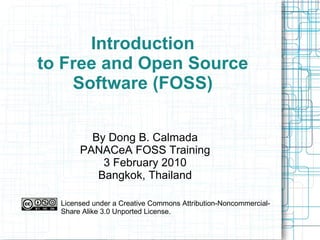
Introduction to Free and Open Source Software (FOSS)
- 1. Introduction to Free and Open Source Software (FOSS) By Dong B. Calmada PANACeA FOSS Training 3 February 2010 Bangkok, Thailand Licensed under a Creative Commons Attribution-Noncommercial-Share Alike 3.0 Unported License.
- 3. FOSS Defined
- 4. Brief Background of FOSS
- 6. Some Benefits of FOSS
- 7. Some Equivalents to Proprietary Softwares/Applications
- 8. When Does One Use FOSS?
- 9. Conclusion
- 11. Understand a brief history of FOSS.
- 12. Appreciate some of the benefits of FOSS.
- 13. Know FOSS equivalents to proprietary softwares/applications
- 14. FOSS defined
- 15. Brief Background of FOSS
- 17. 1976 – Bill Gates' “Open Letter to Hobbyists” advocating that software should be paid for, including royalties
- 18. Early 80s – LISP programming language was taken by MIT, to the dismay of hackers.
- 19. January 1984 – Richard Stallman quit job at MIT. Started to worked on GNU, a set of programming tools.
- 21. 1990 – Bringing 'free software' to the corporate world with Cygnus.
- 22. 1991 – Linus Torvalds distributed a Unix-like kernel and encouraged everyone to help improve it. The kernel was later named “Linux” and then integrated with GNU into an operating system called “GNU/Linux”.
- 24. 1993 – Debian and Slackware as implementations of GNU/Linux were born.
- 25. 1994 – Apache, the now popular web server system, was born.
- 26. 1995 – Red Hat was born.
- 27. 1995 – Codebase of Unix incorporated into systems such as FreeBSD, NetBSD, and OpenBSD.
- 29. 1997 – GNU/Linux grabbed the 25% share of the server market and grew at 25% per year.
- 30. 1997 – GNOME desktop manager was born.
- 31. 1998 – Netscape released Netscape Navigator code base under open source. This paved the way for development of Mozilla Firefox.
- 33. 1999 – Red Hat was transformed into a corporation. Other corporations were established around “selling” Linux: not charging for the software but for the support services.
- 38. Basic security mechanisms are built-in out of the box (compared to Windows' earlier versions)
- 41. Cooperation/collaboration for quality software - “With enough eyeballs, bugs are shallow”
- 43. Some FOSS Equivalents to Proprietary Softwares Category Proprietary FOSS Office Microsoft Office, iWork OpenOffice, KOffice, Abiword, Gnumeric, Lotus Symphony Desktop Publishing Adobe PageMaker Scribus Image Manipulation/Graphics Production Adobe Photoshop GIMP, Inkscape Email Microsoft Outlook, Outlook Express Thunderbird Web Browser Internet Explorer Firefox Voice Over IP Skype Ekiga Database Microsoft Access, SQL Server OpenOffice Base, PostgreSQL, MySQL Media Player Microsoft Media Player, Power DVD Totem, VLC, Mplayer Chat Yahoo Messenger Pidgin, Empathy Video Editing Adobe Premier, Final Cut Cinelerra, Kino
- 45. Using FOSS applications in a proprietary operating system. For example, using OpenOffice for Windows or Mac; using Thunderbird instead of Microsoft Outlook
- 46. Using a Linux distribution as guest operating system in Windows or Mac (through a virtual manager).
- 47. Using cross-platform applications. For example, Apache for web service, mysql for database, PHP for web programming.
- 48. When Does One Use FOSS? (2) Three B's Operating system Desktop Applications Strengths Limitations “ B ut My World” Windows FOSS Applications - Familiarity with Windows - Not insulated from inherent weaknesses of Windows “ B est of Both Worlds” - Dual Boot - Virtual Machine: One OS is treated as guest FOSS Applications - Familiarity with Windows while learning Linux Desktop - Better if the main OS is Linux - Requires high-end machine - Complex setup, requiring networking skills “ B rave New World” Linux FOSS Applications - Total independence from Windows - “Politically-correct” technology use - Steep learning curve about Linux
- 49. Conclusion Using FOSS is cool! It is politically correct (user freedoms) and strategic (mainly business-wise) while working around the policy limits in particular localities/countries. But FOSS is not perfect! Learning curve is steep and requires user-level support on tap. Holding hands together for FOSS! Hand holding to make FOSS flourish!
- 50. Thank you!
- 52. This presentation is an improvement of previous ones I wrote and used in other events.
- 53. Linux distro timeline: http://distrowatch.com/weekly.php?issue=20090105
- 54. Bill Gates' open letter to hobbyists: http://en.wikipedia.org/wiki/Open_Letter_to_Hobbyists
- 58. Connecting and Empowering Communities with FOSS (Dr. Francis Sarmiento, IOSN)
